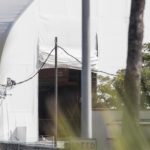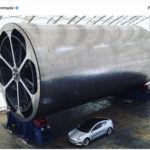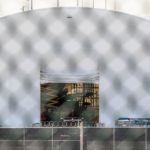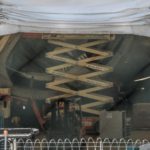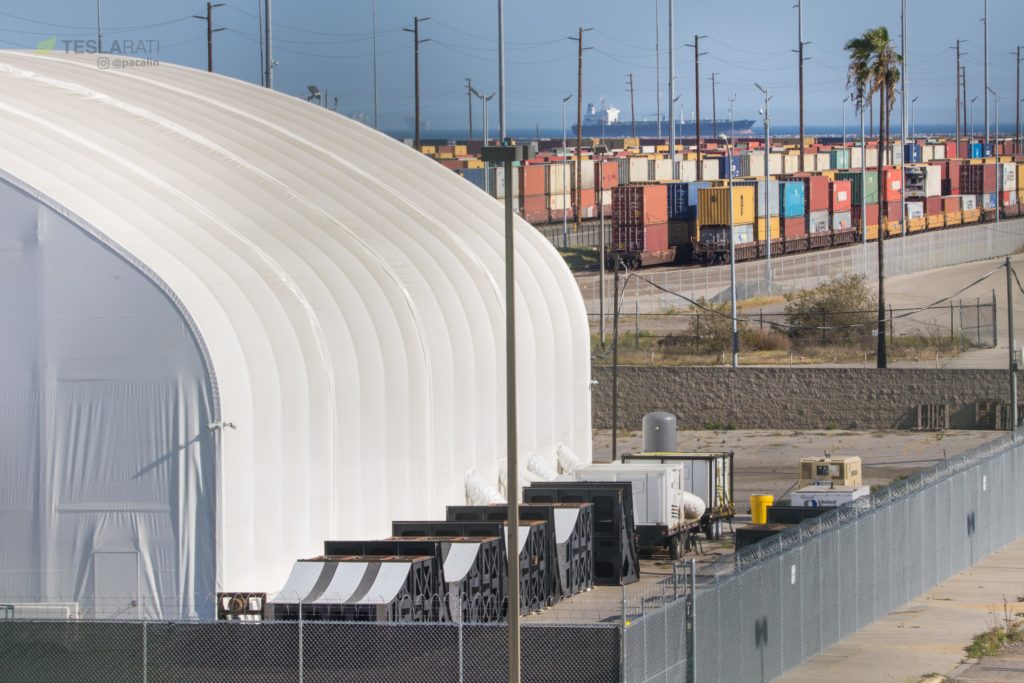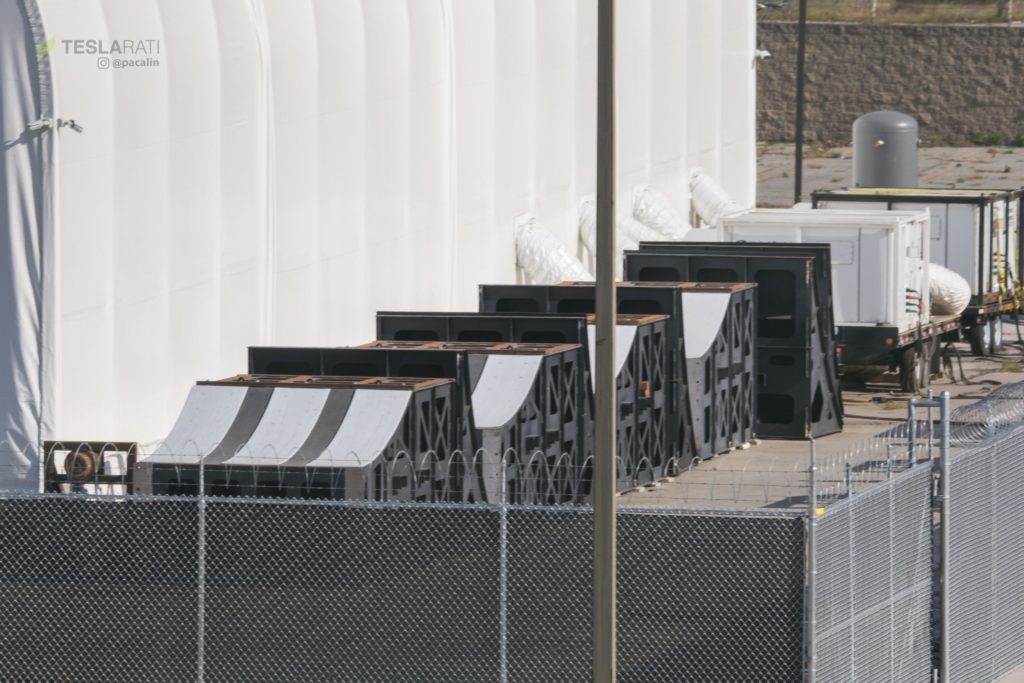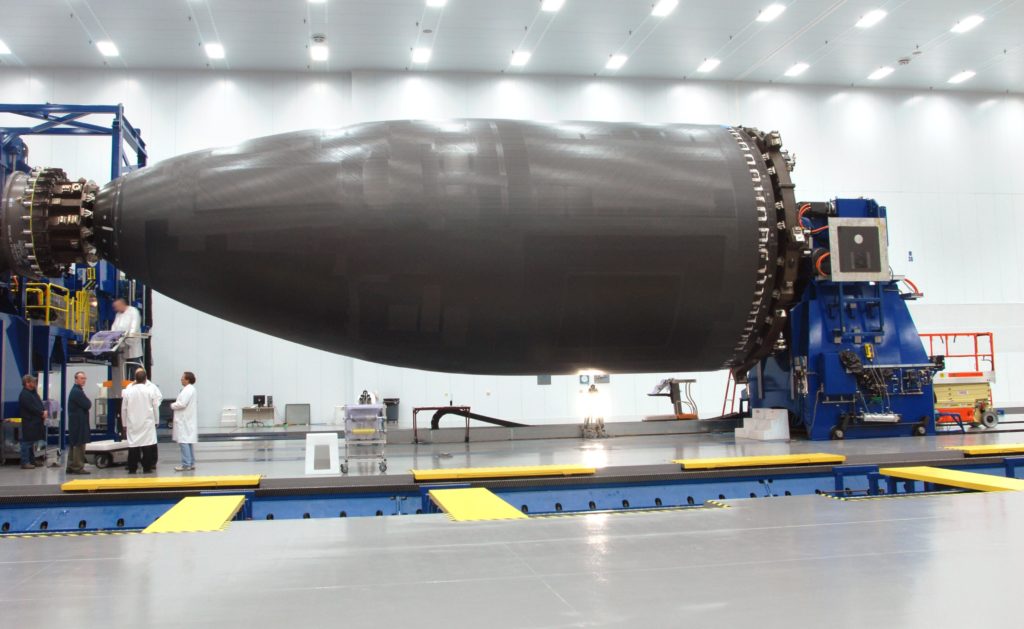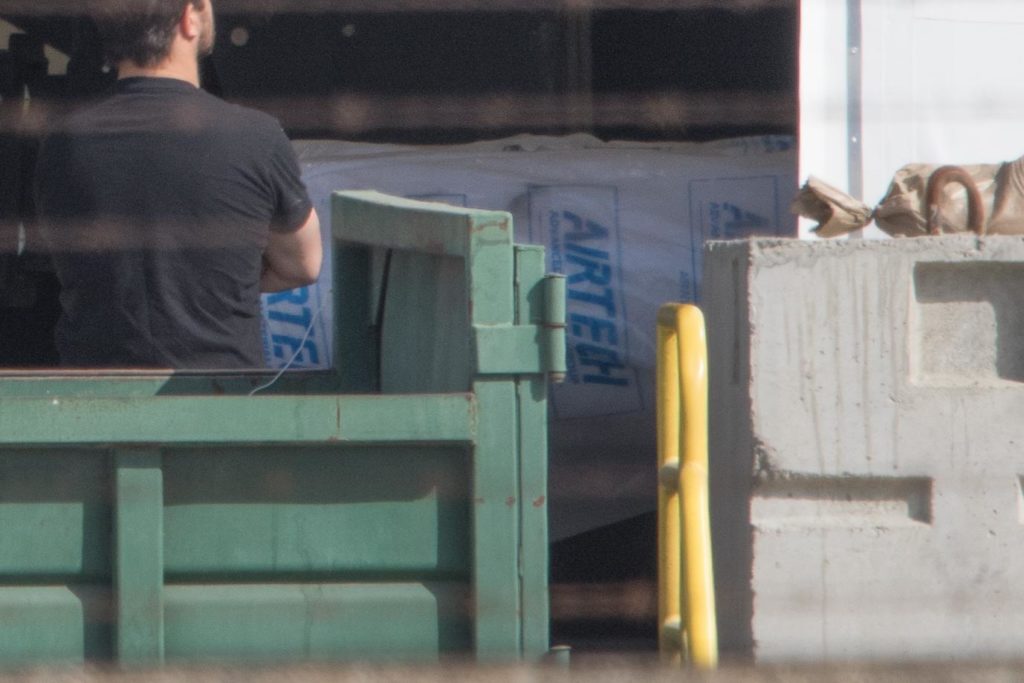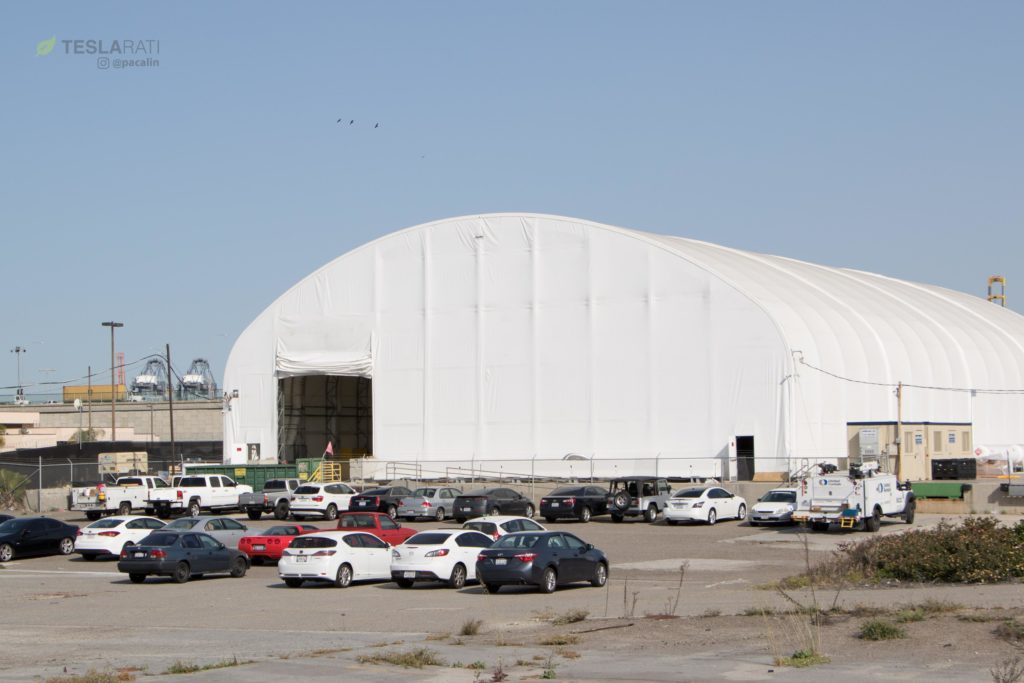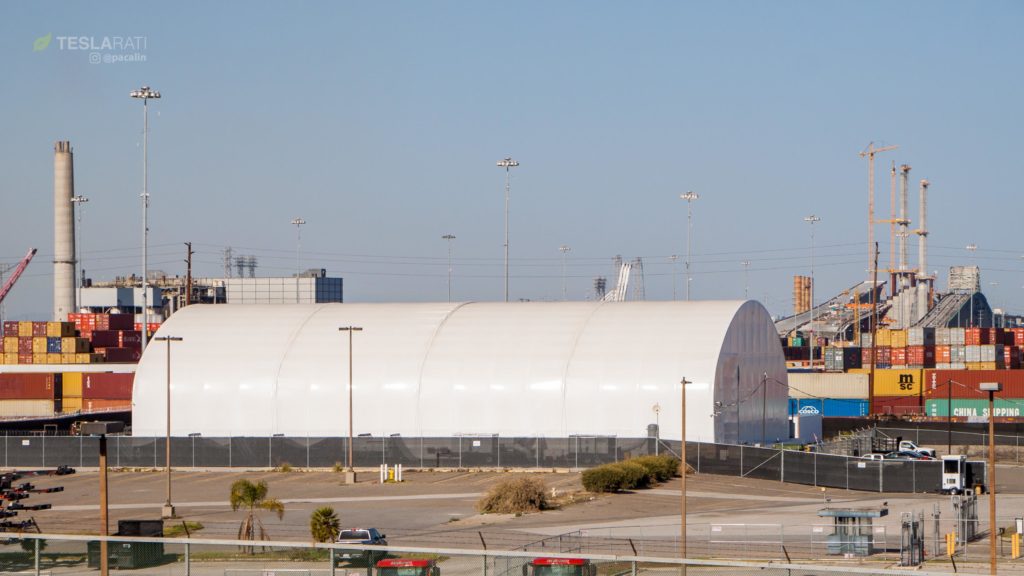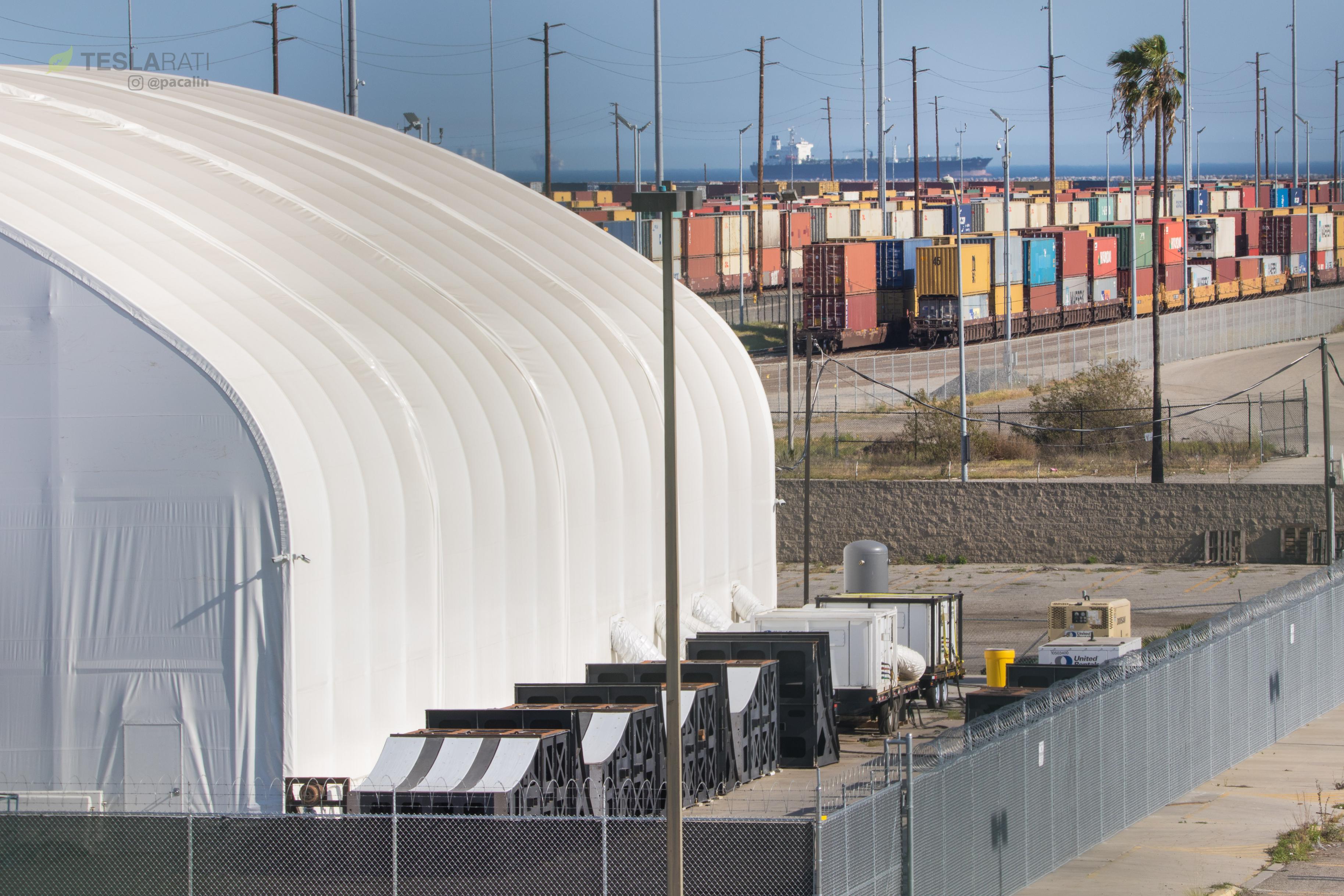

News
SpaceX moving fast on Mars rocket development, BFR tent spied with more tooling
Photos taken by Teslarati photographer Pauline Acalin have confirmed that SpaceX’s massive Mars rocket fabrication tooling has been hiding in plain sight at the company’s Port of San Pedro tent facility.
Spotted inside the temporary structure thanks to open flaps and a human desire for a breeze amidst the warm Los Angeles springtime, the main cylindrical component is truly vast – large enough that the eye almost glazes over it at first glance. Dwarfing the humans clambering about it, very rough estimates using knowledge of the tent’s reported area (20,000 square feet) and size comparisons with machinery blueprints suggest a diameter of around 8-10 meters (26-36 feet), loosely conforming to the expected 9m diameter of BFR, as of CEO Elon Musk’s IAC 2017 update. Recently, however, President Gwynne Shotwell showed off an updated Mars rocket video at TED2018 that led to Musk hinting that BFR may have grown slightly since then.
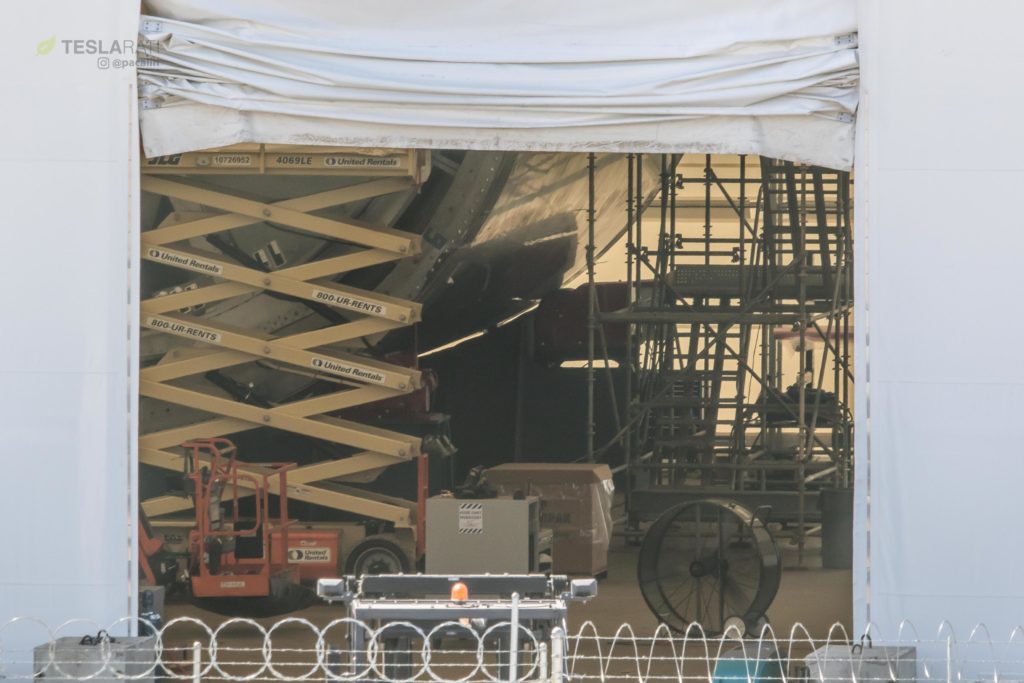
SpaceX’s massive BFR manufacturing tool peeked out from the company’s Port-side tent facility. (Pauline Acalin)
- SpaceX’s BFR tent and mandrel, caught on April 14th. (Pauline Acalin)
- Like, really big. (Pauline Acalin)
The massive cylindrical structure teased by Musk earlier this month is most likely a mandrel, a tool that can be spun on its horizontal axis to weave predetermined structures. In the case of the Mars rocket mandrel, it will likely be used to carefully wind dozens or hundreds of layers of carbon fiber (known as prepreg), interspersed with layers of laminate and various epoxies and resins. It’s also possible, however, that the massive tool is instead a multipurpose mold and autoclave, where the composite layers would be lain on the inside of the cylinder, allowed to set, and eventually sealed inside and heat/pressure treated.
Images of the machinery are fairly ambiguous: they show a structure that could have connection points one might find on an autoclave, as well as what appears to be a thick and well-insulated internal wall. However, the external skin appears to be a relatively thin sheet of metal, which would point more towards a traditional composite mandrel, where certain sheets could be removed or modified as needed to create desired shapes in the composite while it’s being formed, less risky than machining a completed segment.
- Just a casual line of car-sized steel segments hanging around outside the BFR tent. (Pauline Acalin)
- While unclear, these are likely sections of a layup or mold that will be used to form BFR’s more complex composite components. (Pauline Acalin)
- Shown is the forward fuselage of the 787 on a mandrel for composite weaving and layup.(Boeing)
Perhaps even more interesting, a number of massive metal structures were spotted just outside of the tent. While it is unclear what exactly their purpose was, is, or will be, it’s more likely than not that they are components of a carbon composite mold or layup structure meant to deal with fabrication of certain Mars rocket and spaceship components with complex curves, versus the relatively simple cylinders that BFR and BFS are largely comprised of. Still, precedents exist in large aerospace composite manufacturing for the fabrication of structures with complex curves, most notably the nose and front sections of airliners like Boeing’s 787.
Finally, it’s worth noting just how shockingly busy the BFR tent was on both April 13th and 14th, as well as the 8th (the first day Pauline visited the facility). With upwards of 40 cars parked at the tent, it’s blindingly clear that SpaceX is not simply using the tent as a temporary storage location – alongside the arrival of composite fabrication materials (prepreg sheets, epoxy, etc) from Airtech International, SpaceX undeniably intends to begin initial fabrication of the first BFR prototypes in this tent, although they will likely eventually move the activities to the Berth 240 Mars rocket factory. That’s certainly not a sentence I ever expected to write, but it is what it is.
- Airtech supplies arrive at the BFR tent on April 14. Airtech is a composites supplier with a branch located just miles away from Port of San Pedro. (Pauline Acalin)
- Lots of cars at the BFR tent. This also provides a sense of scale for the tent’s absolutely massive access flaps. (Pauline Acalin)
- April 2018. (Pauline Acalin)
SpaceX’s giant, temporary tent currently housing the company’s BFR/BFS fabrication tooling while their permanent facility awaits construction a couple miles away. #SpaceX #BFR pic.twitter.com/a8Tj6QLmUz
— Pauline Acalin (@w00ki33) April 15, 2018
Follow us for live updates, behind-the-scenes sneak peeks, and a sea of beautiful photos from our East and West coast photographers.
Teslarati – Instagram – Twitter
Tom Cross – Twitter
Pauline Acalin – Twitter
Eric Ralph – Twitter
News
Tesla begins Robotaxi certification push in Arizona: report
Tesla seems serious about expanding its Robotaxi service to several states in the coming months.

Tesla has initiated discussions with Arizona transportation regulators to certify its driverless Robotaxi service in the state, as per a recent report from Bloomberg News. The move follows Tesla’s launch of its Robotaxi pilot program in Austin, Texas, as well as CEO Elon Musk’s recent comments about the service’s expansion in the Bay Area.
The Arizona Department of Transportation confirmed to Bloomberg that Tesla has reached out to begin the certification process for autonomous ride-sharing operations in the state. While details remain limited, the outreach suggests that Tesla is serious about expanding its driverless Robotaxi service to several territories in the coming months.
The Arizona development comes as Tesla prepares to expand its service area in Austin this weekend, as per CEO Elon Musk in a post on X. Musk also stated that Tesla is targeting the San Francisco Bay Area as its next major market, with a potential launch “in a month or two,” pending regulatory approvals.
Tesla first launched its autonomous ride-hailing program on June 22 in Austin with a small fleet of Model Y vehicles, accompanied by a Tesla employee in the passenger seat to monitor safety. While still classified as a test, Musk has said the program will expand to about 1,000 vehicles in the coming months. Tesla will later upgrade its Robotaxi fleet with the Cyercab, a two-seater that is designed without a steering wheel.
Sightings of Cybercab castings around the Giga Texas complex suggests that Tesla may be ramping the initial trial production of the self-driving two-seater. Tesla, for its part, has noted in the past that volume production of the Cybercab is expected to start sometime next year.
In California, Tesla has already applied for a transportation charter-party carrier permit from the state’s Public Utilities Commission. The company is reportedly taking a phased approach to operating in California, with the Robotaxi service starting with pre-arranged rides for employees in vehicles with safety drivers.
News
Tesla sets November 6 date for 2025 Annual Shareholder Meeting
The automaker announced the date on Thursday in a Form 8-K.

Tesla has scheduled its 2025 annual shareholder meeting for November 6, addressing investor concerns that the company was nearing a legal deadline to hold the event.
The automaker announced the date on Thursday in a Form 8-K submitted to the United States Securities and Exchange Commission (SEC). The company also listed a new proposal submission deadline of July 31 for items to be included in the proxy statement.
Tesla’s announcement followed calls from a group of 27 shareholders, including the leaders of large public pension funds, which urged Tesla’s board to formally set the meeting date, as noted in a report from The Wall Street Journal.
The group noted that under Texas law, where Tesla is now incorporated, companies must hold annual meetings within 13 months of the last one if requested by shareholders. Tesla’s previous annual shareholder meeting was held on June 13, 2024, which placed the July 13 deadline in focus.
Tesla originally stated in its 2024 annual report that it would file its proxy statement by the end of April. However, an amended filing on April 30 indicated that the Board of Directors had not yet finalized a meeting date, at least at the time.
The April filing also confirmed that Tesla’s board had formed a special committee to evaluate certain matters related to CEO Elon Musk’s compensation plan. Musk’s CEO performance award remains at the center of a lengthy legal dispute in Delaware, Tesla’s former state of incorporation.
Due to the aftermath of Musk’s legal dispute about his compensation plan in Delaware, he has not been paid for his work at Tesla for several years. Musk, for his part, has noted that he is more concerned about his voting stake in Tesla than his actual salary.
At last year’s annual meeting, TSLA shareholders voted to reapprove Elon Musk’s compensation plan and ratified Tesla’s decision to relocate its legal domicile from Delaware to Texas.
Elon Musk
Grok coming to Tesla vehicles next week “at the latest:” Elon Musk
Grok’s rollout to Tesla vehicles is expected to begin next week at the latest.

Elon Musk announced on Thursday that Grok, the large language model developed by his startup xAI, will soon be available in Tesla vehicles. Grok’s rollout to Tesla vehicles is expected to begin next week at the latest, further deepening the ties between the two Elon Musk-led companies.
Tesla–xAI synergy
Musk confirmed the news on X shortly after livestreaming the release of Grok 4, xAI’s latest large language model. “Grok is coming to Tesla vehicles very soon. Next week at the latest,” Musk wrote in a post on social media platform X.
During the livestream, Musk and several members of the xAI team highlighted several upgrades to Grok 4’s voice capabilities and performance metrics, positioning the LLM as competitive with top-tier models from OpenAI and Google.
The in-vehicle integration of Grok marks a new chapter in Tesla’s AI development. While Tesla has long relied on in-house systems for autonomous driving and energy optimization, Grok’s integration would introduce conversational AI directly into its vehicles’ user experience. This integration could potentially improve customer interaction inside Tesla vehicles.
xAI and Tesla’s collaborative footprint
Grok’s upcoming rollout to Tesla vehicles adds to a growing business relationship between Tesla and xAI. Earlier this year, Tesla disclosed that it generated $198.3 million in revenue from commercial, consulting, and support agreements with xAI, as noted in a report from Bloomberg News. A large portion of that amount, however, came from the sale of Megapack energy storage systems to the artificial intelligence startup.
In July 2023, Musk polled X users about whether Tesla should invest $5 billion in xAI. While no formal investment has been made so far, 68% of poll participants voted yes, and Musk has since stated that the idea would be discussed with Tesla’s board.
-

 Elon Musk1 week ago
Elon Musk1 week agoTesla investors will be shocked by Jim Cramer’s latest assessment
-

 Elon Musk19 hours ago
Elon Musk19 hours agoxAI launches Grok 4 with new $300/month SuperGrok Heavy subscription
-

 Elon Musk3 days ago
Elon Musk3 days agoElon Musk confirms Grok 4 launch on July 9 with livestream event
-

 News7 days ago
News7 days agoTesla Model 3 ranks as the safest new car in Europe for 2025, per Euro NCAP tests
-

 Elon Musk2 weeks ago
Elon Musk2 weeks agoA Tesla just delivered itself to a customer autonomously, Elon Musk confirms
-

 Elon Musk1 week ago
Elon Musk1 week agoxAI’s Memphis data center receives air permit despite community criticism
-

 Elon Musk2 weeks ago
Elon Musk2 weeks agoTesla’s Omead Afshar, known as Elon Musk’s right-hand man, leaves company: reports
-

 News2 weeks ago
News2 weeks agoXiaomi CEO congratulates Tesla on first FSD delivery: “We have to continue learning!”

